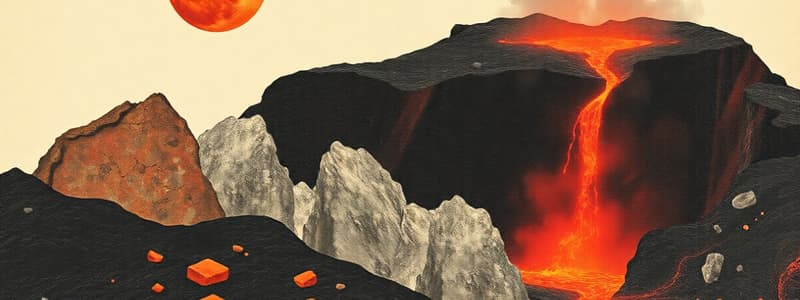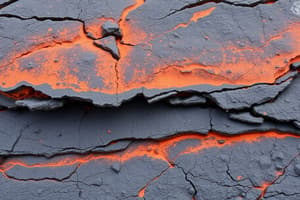Podcast
Questions and Answers
What are minerals?
What are minerals?
Minerals are naturally occurring, inorganic solids with a definite chemical composition and a crystalline structure.
What is magma?
What is magma?
Magma is molten rock found beneath the Earth's surface, consisting of liquid rock, crystals, and dissolved gases.
How is lava different from magma?
How is lava different from magma?
Lava is magma that has reached the Earth's surface.
What is the rock cycle?
What is the rock cycle?
How are igneous rocks formed?
How are igneous rocks formed?
Intrusive igneous rocks cool quickly on the surface.
Intrusive igneous rocks cool quickly on the surface.
Give an example of an intrusive igneous rock.
Give an example of an intrusive igneous rock.
What process forms sedimentary rocks?
What process forms sedimentary rocks?
How are metamorphic rocks formed?
How are metamorphic rocks formed?
Weathering is the process of moving weathered material.
Weathering is the process of moving weathered material.
What is erosion?
What is erosion?
Define ore and give examples.
Define ore and give examples.
The process of separating solids from liquids is called _________.
The process of separating solids from liquids is called _________.
Flashcards are hidden until you start studying
Study Notes
Minerals
- Naturally occurring, inorganic solids with a definite chemical composition and crystalline structure.
- Examples: Quartz, feldspar, and mica.
Magma and Lava
- Magma: Molten rock found beneath the Earth's surface.
- Contains a mixture of liquid rock, crystals, and dissolved gases.
- Lava: Magma that has reached the Earth's surface through volcanic eruptions.
- Lava forms igneous rock when it cools and solidifies.
The Rock Cycle
- Continuous process of transforming rocks from one type to another.
- Involves formation, breakdown, and reformation of rocks through processes like cooling, erosion, sedimentation, and metamorphism.
Formation of Igneous Rocks
- Formed from the solidification of magma or lava.
- Intrusive igneous rocks: Formed from magma cooling slowly beneath the Earth's surface (thousands to million of years).
- Extrusive igneous rocks: Formed from lava cooling quickly on the surface (days to weeks).
Intrusive vs. Extrusive Igneous Rocks
- Intrusive: Larger crystals due to slow cooling (examples: granite and diorite).
- Extrusive: Smaller crystals or may be glassy due to rapid cooling (examples: basalt and pumice).
Formation of Sedimentary Rocks
- Formed through the accumulation and compaction of sediment (fragments of other rocks, minerals, and organic material).
- Process can take thousands to millions of years depending on environment and conditions.
- Examples: Sandstone, limestone, and shale.
Formation of Metamorphic Rocks
- Formed from existing rocks (igneous, sedimentary, or other metamorphic rocks) undergoing changes due to high temperature, high pressure, or chemically active fluids.
- Metamorphosis can take thousands to millions of years.
- Examples: Schist, gneiss, and marble.
Classifying Rocks
- Metamorphic Rocks: Formed from alteration of existing rocks, often have a foliated or banded appearance, and can contain larger crystals due to recrystallization (e.g., schist, gneiss).
- Igneous Rocks: Formed from solidification of molten rock, crystal size varies depending on cooling rate (e.g., granite - intrusive, basalt - extrusive).
- Sedimentary Rocks: Formed from accumulation of sediment, often have a layered appearance, may contain fossils and have varying grain sizes (e.g., sandstone, limestone).
Weathering, Erosion, and Deposition
- Weathering: Breaking down rocks into smaller pieces through physical, chemical, or biological means.
- Erosion: Removal and transportation of weathered material from one location to another, often by wind, water, or ice.
- Deposition: Eroded material is deposited in a new location, leading to the formation of new geological features.
Ore
- Naturally occurring solid material from which a metal or valuable mineral can be extracted profitably
- Examples: Iron ore, copper ore, gold ore.
Types of Mineral Separation
- Filtration: Separating solids from liquids by passing the mixture through a filter.
Studying That Suits You
Use AI to generate personalized quizzes and flashcards to suit your learning preferences.




